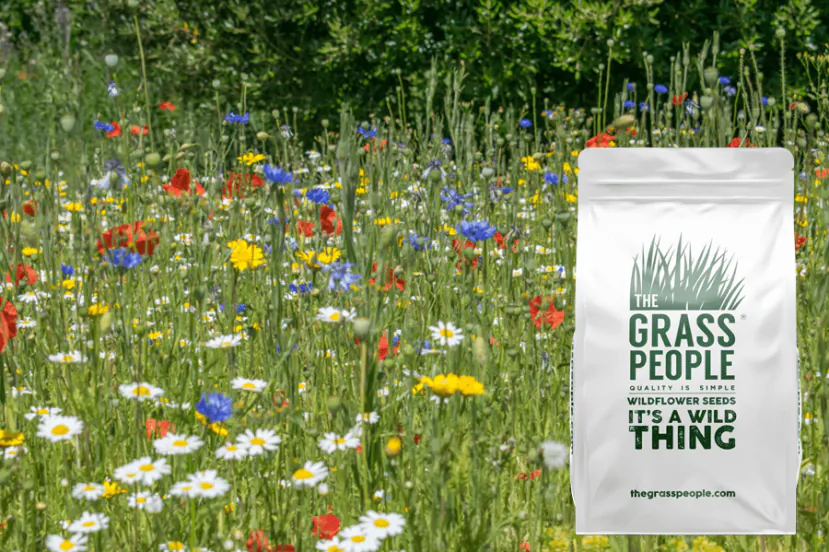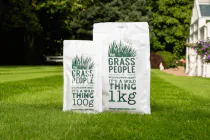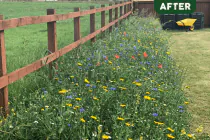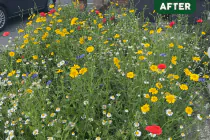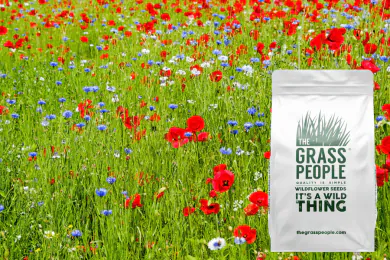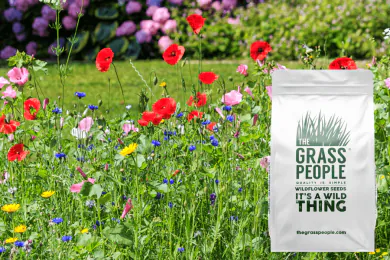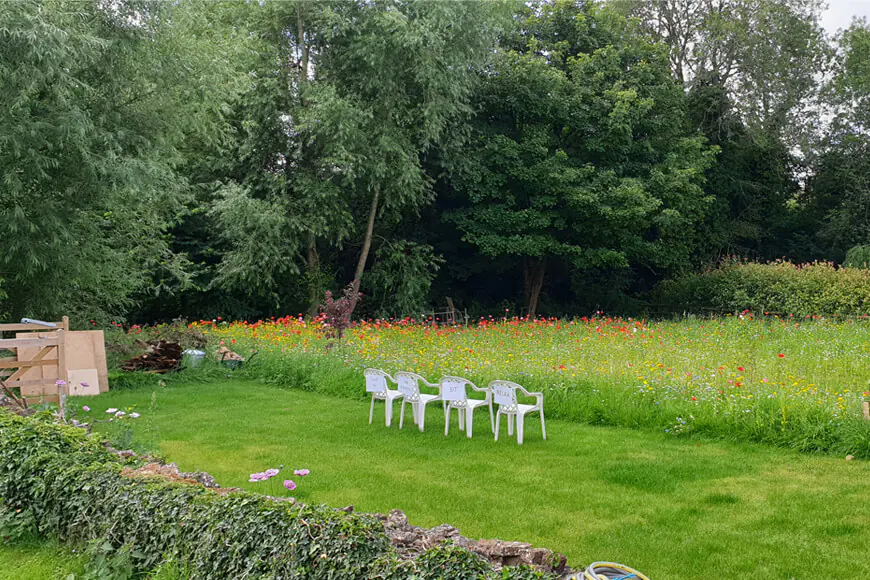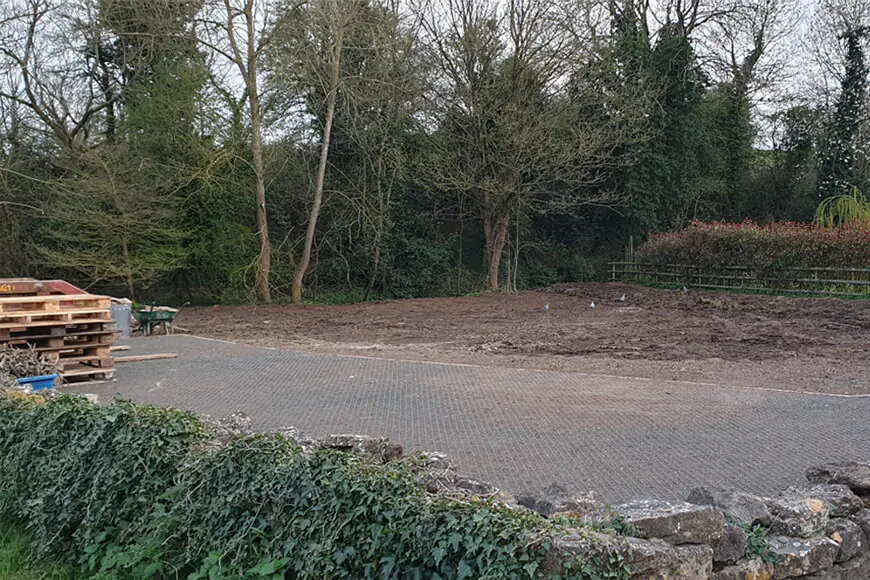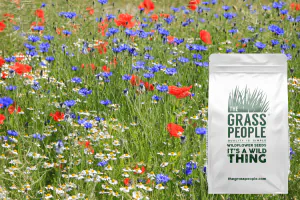Flowering Meadow Wildflowers
- Creates a delightful display of cornfield annuals and long-lasting perennials
- Develops a year-round habitat for bees and pollinators
- Contains sought-after UK native wildflowers
Please refresh the page in 1 minute to see the next delivery time.
How much do I need?
Simply enter the length and width of the area, to calculate how much you need.
Product Description
Flowering Meadow contains a simply stunning array of classic British cornfield annuals and longer-lasting perennial wildflowers. The grass species in this mix are meticulously matched to their wildflower counterparts to create a meadow as it would naturally occur in uncultivated land. The grass in this mix will grow first after sown, creating a nursery for the RHS Plant for Pollinators wildflowers to thrive in.
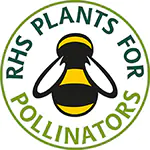
Mixture Breakdown
June - August
What colour is it?Violet
Annual or Perennial?Annual
Latin NameCentaurea cyanus
DescriptionCornflower was previously considered a weed in amongst its cornfield annuals companions but is now accepted and widely praised as one of its finest! We're not surprised - who could dismiss those electric blue blooms?
May – September
What colour is it?Purple
Annual or Perennial?Annual
Latin NameAgrostemma githago
DescriptionCorncockle is a pretty purple wildflower with tall stems and full petals and is a bright addition to any annuals mix. It is currently rare and endangered.
June - September
What colour is it?White
Annual or Perennial?Perennial
Latin NameDaucus carota
DescriptionPart of the carrot family, Wild Carrot smells like carrots but is not the kind of one you would want to eat. Its low nutrient and drought tolerant abilities make it ideal for sandy soils.
June - August
What colour is it?Red / Black
Annual or Perennial?Annual
Latin NamePapaver rhoeas
DescriptionCorn Poppy is a vibrant and bright addition to any meadow and easily recognisable and identifiable throughout the UK. Of course it has meaning for many, and also adds a colourful pop to any wildflower plot!
June - September
What colour is it?White / Yellow
Annual or Perennial?Annual
Latin NameAnthemis arvensis
DescriptionAlthough Corn Chamomile looks like a daisy, it is part of the cornfield annuals family. With its flat and almost-level surface it makes the perfect pit-stop for bees and pollinators.
March - November
What colour is it?Pink
Annual or Perennial?Perennial
Latin NameSilene dioica
DescriptionRed Campion has hot pink petals that make for quite the show stopper in your wildflower meadow, and can typically be found in woodland areas. Red Campion begins to flower once bluebells begin to fade, so if you notice this happening in your wildflower sward you can begin to look forward to their fuchsia blooms!
May – September
What colour is it?Pink / Green
Annual or Perennial?Perennial
Latin NameSanguisorba minor
DescriptionA perennial wildflower with toothed leaves and pink flowers, its leaves when crushed smell like cucumber and used to be used in salads!
May – September
What colour is it?Yellow / Red
Annual or Perennial?Perennial
Latin NameLotus corniculatus
DescriptionBirdsfoot Trefoil is part of the pea family and grows up to 35cm. It is well known for its yellow slipper like petals and red centre, which has given it the nickname of 'Eggs and Bacon'!
May - June
What colour is it?White
Annual or Perennial?Perennial
Latin NameAnthriscus sylvestris
DescriptionCow Parsley is a shade tolerant wildflower that can be found naturally growing in woodland areas and its stem branches out into many clusters of tiny white flowers. It is sometimes referred to as 'Queen Anne's Lace' as it was said it would bloom for Queen Anne and her ladies in waiting and resembled the lace on their dresses.
July – August
What colour is it?Pink / Lilac
Annual or Perennial?Perennial
Latin NameMalva moschata
DescriptionMusk Mallow is a light pink perennial that sits open and welcome for bees to land on. It’s easy to access pollen makes it the ideal flower for attracting bees alongside its sweet musky scent that invites them to pop in for more than just a pit stop!
June - September
What colour is it?Pink / Purple
Annual or Perennial?Perennial
Latin NameDigitalis purpurea
DescriptionFoxgloves are biennial wildflowers that when sown will reward you with blooms for two whole years. Their bright pink / purple bells are attractive to bees and pollinators who tunnel in to feed on its nectar.
June - September
What colour is it?Yellow
Annual or Perennial?Perennial
Latin NameAgrimonia eupatoria
DescriptionAgrimony is a spikey perennial wildflower with buttercup-like blooms which stems can grow up to 80cm!
January – December
What colour is it?White / Brown
Annual or Perennial?Perennial
Latin NamePlantago lanceolata
DescriptionRibwort Plantain although not the brightest wildflower, certainly adds a natural diversity to your wildflower meadow. Its tiny white buds provide food for bees and pollinators whilst its seeds are great for Goldfinches.
June - October
What colour is it?Yellow
Annual or Perennial?Annual
Latin NameGlebionis segetum
DescriptionCorn Marigold is a bright ray of sunshine on a gloomy day. Its orange-yellow petals burst into life in June and last all the way through until October. Part of the cornfield annuals family, although this annual may have one showing - it’s a showstopper!
June to September
What colour is it?Pink, white
Annual or Perennial?Perennial
Latin NameSaponaria officinalis
DescriptionThis plant grows green, leafy stems that do not have any side branches. When it blooms, the flowers form in clusters of pink and white petals that produce a sweet scent.
May to September
What colour is it?White
Annual or Perennial?Perennial
Latin NameSilene vulgaris
DescriptionThis perennial plant gets its name from its bladder-like calyx with purple veins, just behind the flowers. The flowers have 5 2-lobed petals and are white in colour.
This is a grass seed and typically germinates at temperatures of 8 -10 degrees
What colour is it?Green / Beige
Annual or Perennial?Perennial
Latin NameCynosurus cristatus
DescriptionCrested Dogstail is a grass that performs in most soil types
This is a grass seed and typically germinates at temperatures of 8 -10 degrees
What colour is it?Green / Beige
Annual or Perennial?Perennial
Latin NameDeschampsia cespitosa
DescriptionTufted Hair Grass is a grass that performs in most soil types
This is a grass seed and typically germinates at temperatures of 8 -10 degrees
What colour is it?Green / Beige
Annual or Perennial?Perennial
Latin NameAgrostis vinealis
DescriptionBrowntop Bentgrass is a grass that performs in most soil types
This is a grass seed and typically germinates at temperatures of 8 -10 degrees
What colour is it?Green / Beige
Annual or Perennial?Perennial
Latin NameArrhenatherum elatius
DescriptionTall Oat Grass is a grass that performs in most soil types
This is a grass seed and typically germinates at temperatures of 8 -10 degrees
What colour is it?Green / Beige
Annual or Perennial?Perennial
Latin NameFestuca ovina
DescriptionSheeps Fescue is a grass that performs in most soil types
This is a grass seed and typically germinates at temperatures of 8 -10 degree
What colour is it?Green / Beige
Annual or Perennial?Perennial
Latin NameFestuca rubra
DescriptionSlender Creeping Red Fescue is a grass that performs in most soil types
This is a grass seed and typically germinates at temperatures of 8 -10 degrees
What colour is it?Green / Beige
Annual or Perennial?Annual
Latin NameFestuca rubra ssp. Commutata
DescriptionChewing's Fescue is a grass that performs in most soil types
Usage Guide
● Remove any existing grass, plants or flora from the area where you plan to sow your wildflower seed. Failure to do this will produce poor results
● Further remove the top 5-10cm to reduce soil fertility
● Allow the area to cultivate for several weeks, and remove any weeds that may pop in the area during this time
● Do not be tempted to add top soil, compost or fertiliser to the area - wildflowers prefer low nutrient conditions
● After the cultivation period ensure to remove stones or any other debris and rake the area to create a fine, friable and level seedbed
● Scatter the seed at a rate of 5g per m2
● Rake the seed so that it is in amongst the soil
● Water the just-sown wildflower seed well
● If sowing in drought conditions, water as required to keep the area moist in the first 6 weeks after sowing
Read our full guide on how to manage your wildflower meadow here.
| Sowing Rate | 5g per m2 |
| When | For best results sow in March/April or in September |
Aftercare
End of year cut:
- We recommend doing this essential end-of-year cut in autumn.
- Your wildflowers are ready for their first cut when they have grown to 7cm and have gone to seedhead.
- This cut can be done using your lawn mower at its highest setting or using a strimmer.
Early spring cut:
- An early spring cut is ideal when your wildflowers are well-established.
- This early spring cut trims back meadow grasses and helps increase the density of the wildflowers.
- This cut also encourages wildflowers to grow better later that season.
- Cut before the end of April, or you may stunt their growth, and they could skip blooming that year.
Summer cut (optional):
- A cut between June and August can encourage the growth of wildflowers later in the season.
- Cut back to 7cm tall and remove the cuttings.
- This optional cut encourages new wildflowers to grow and flourish.
What to do with the cuttings (if you have annual wildflowers in the mix):
In dry conditions:
- If conditions will be dry for 5-7 days, you can let the cuttings lie on the ground so the seeds drop.
- Walk over, use a roller or shake the seedheads to encourage the seeds to fall and grow next season.
- Then remove the plant cuttings after a week and dispose of them in your garden waste bin.
In wet conditions:
- Lift the clippings if rainfall is forecast, and manually free up the seeds by crushing the seedhead to collect the seeds for replanting.
- When dry conditions return, scatter the seeds across your wildflower area.
- Alternatively, you can store your collected wildflower seeds in an envelope and replant them later.
For further reading, check out our guide on when and how often to cut a wildflower meadow.
The above photo depicts the variety of species you should expect to see in your wildflower display. Please note that certain species within this mix and all our wildflower mixes may become more abundant than others, and this varies based on the conditions in which they are sown. Taking this into consideration, your wildflower meadow will evolve and adapt year after year and change in appearance as certain species may become more dominant than others.
Product Questions
Product Questions
I sowed my mix three weeks ago and I can see some things sprouting but I am unsure whether it is some of the original grass (I did dig 10cm down!) or weeds - how do you know whether to pull them out/let them grow? Should I leave it a few more weeks? I don’t want the grass/weeds to kill off the plants? I can also still see some seeds, is that normal or should I tread/rake them in?
Thanks,
Do not pull anything just yet. These are likely to be the meadow grasses, these will appear first creating a nursery for the wildflowers. Over the next few weeks you can expect to see more annuals bloom and some perennials, however most perennials will appear in next years bloom.
Will they return this year?
No one wildflower meadow will look the same year on year, making them so unique!
The success and results of your meadow rely on many factors such as weather, soil and available space, which can change from year to year. For example, annuals will appear one year and not the next, whereas the perennials that did not bloom the first will make an appearance the second year.
Depending on the conditions, some wildflower varieties will thrive whilst others will struggle, making the outcome of a meadow so unpredictable yet exciting.
For more info on this, you can check out our guide here: https://thegrasspeople.com/wildflower-101-faq-wildflowers/
Is now a good time to overseed the area with a pollinator mix to give more colour next year? If not now, when should I do it and how should I prepare the ground?
Could you please tell me if this flower meadow would be harmful to horses if eaten, we have horses in a field next door to our garden.
Many Thanks
John
We would not recommend sowing wildflower seeds near grazing areas. Whilst most wildflowers are relatively safe, there are a few that can be harmful to animals when ingested.
Is this mix suitable for pots rather than spreading on the ground as a meadow and if so what type of soil would you recommend and how often should they be watered / fed?
Thanks
Lynsey
Whilst you can sow in planters, wildflowers much prefer poor soil conditions and a low fertile environment. Topsoil and compost can sometimes be too rich in nutrients. If you are going to sow then we suggest using soil from the garden. It will need watered daily for the first few weeks and in the absence of rain but it will not fertilised.
If you keep the in a cool dry place until you are ready to sow then that will be fine. Somewhere like a garage or shed would be suitable.
Thanks.
Yes, we would recommend that you avoid walking on the area, at least for the first few weeks. Once the grass is established then you should be fine to use the lawn as normal.
Thanks Roisin
Does this mix only contain hardy plants? I wanted to check there are no half-hardy annuals as wish to sow now (October),
Many thanks
Thanks very much for your enquiry. This is mix has a vast variety of wildflowers and contains corn poppy and corn chamomile which are pretty hard. Autumn is a great time sow any of our mixes. Now is an ideal time because the seeds need to undergo the process of stratification (a freeze) to kick start their germination. If you were to sow the seed now, nothing will happen until next spring, early in the season. If you decide to wait until next year and sow in the spring, then your meadow will flower in the summer. We do have a few blog posts on our website that go into more details.
